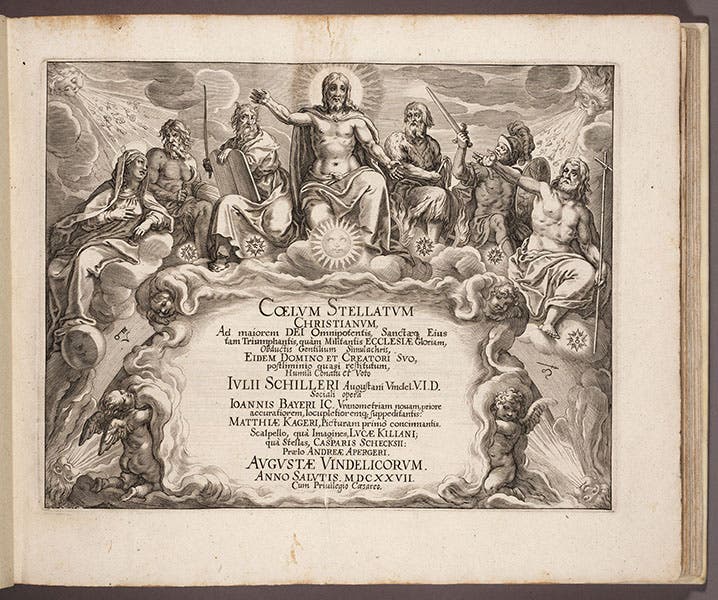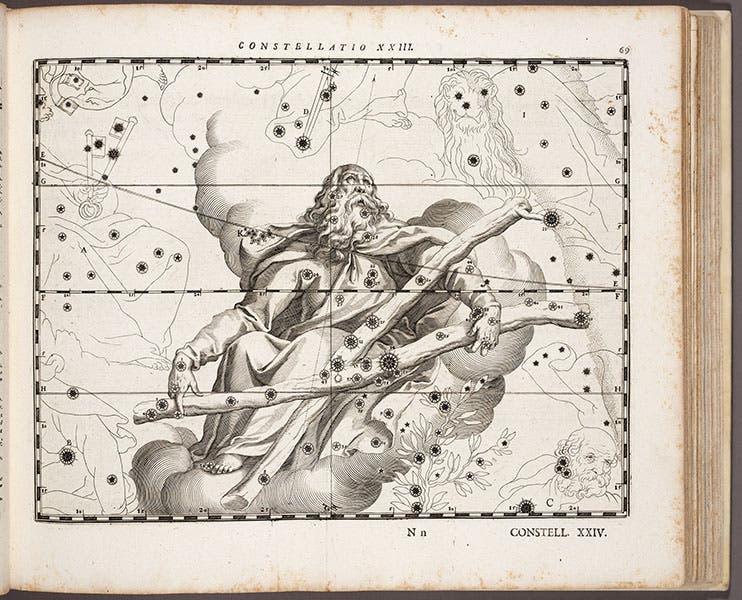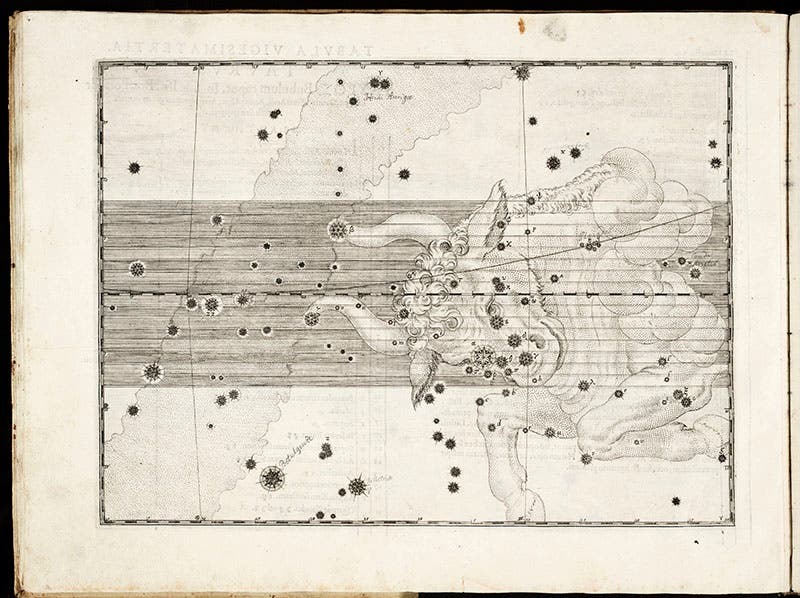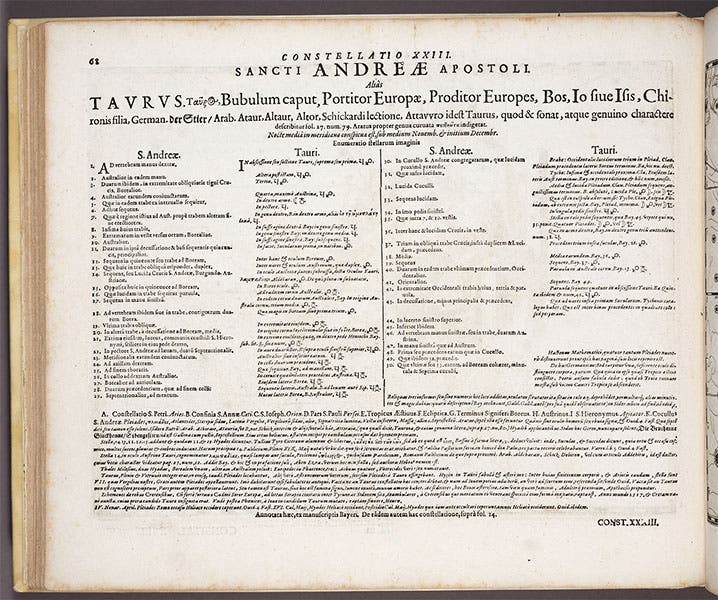Scientist of the Day - Julius Schiller
Julius Schiller, a German lawyer and astronomer, died, it is thought, in 1627; his birth date is not known. Schiller is known for a single pair of works, both published in 1627, the year he is supposed to have died. Schiller lived and worked in Augsburg; in 1603, Augsburg had seen the publication of what is often called the first modern star atlas, the Uranometria, compiled by Johann Bayer. The atlas has 51 engraved plates: 48 of them showing the 48 traditional Ptolemaic constellations. Not only are the constellation figures beautifully drawn, but the stars are positioned according to the very recent star catalogue of Tycho Brahe. So it was not only the most beautiful star atlas published to date, but the most accurate.
Schiller knew Bayer well and may even have worked on the production of his atlas. But he had a problem with the work: it gave extended life to the pagan constellations that were fine in their time but hardly appropriate for a Christian age. So Schiller set out to produce a revision of the Uranometria, replacing all of the ancient constellations with Christian ones. He was very systematic about it; since there were 12 zodiac constellations, they could be easily replaced with the twelve apostles. The mythological figures in the northern hemisphere were replaced by New Testament figures, while the figures of the southern hemisphere gave way to Old Testament figures. Schiller tried to make the replacements a good fit; the ship of the Argonauts, Argo, yielded to Noah's ark (first image); the river Eridanus became the river Jordan.
Schiller’s Coelum stellatum Christianum was published in 1627, with a splendid engraved titlepage (second image), indicating that not just the stars, but the planets too were to be renamed for biblical figures. Schiller’s Coelum has the same size and format as the Uranometria, with 51 plates, numbered identically to those in Bayer’s atlas. Of the two images just above, the top one is Schiller’s plate for St. Andrew; just below is the corresponding plate of Taurus from Bayer’s Uranometria. You can see that Schiller was rather clever in the way he redesigned the heavens; the Hyades, which so nicely outline the face of the Bull in Bayer, seem equally appropriate in forming the V-shape of Andrew’s cross. We also notice something else: the stars on the two plates, Andrew and Taurus, are in mirror-image positions. Bayer had shown the stars and constellations as if viewed from the Earth; Schiller preferred to show the stars as if they were placed on a globe, that is, from the outside.
Schiller not only redesigned the constellations; he renamed all the stars. Stars were traditionally named after their position in the constellation, so clearly the “eye of the Bull” would no longer do as a label. If your consult the table that lies opposition the plate of St. Andrew (fifth image, just above), you can see both the old names for every star and Schiller’s new ones.
We offer a second set of plates, Schiller and Bayer, just above, for further comparison: Schiller’s Sepulcher (sixth image), and Bayer’s Andromeda (seventh image). If you could enlarge them (and since both of our copies are available online, you can do just that), you would see that some of the star positions are different, and Schiller’s plate has more stars than Bayer’s; indeed, Schiller even has a new heavenly object, the great nebula of Orion (or of the Sepulcher), which was unknown to Bayer but known to Schiller. Schiller’s atlas was not just a cosmetic change; it is really a more complete and more accurate star atlas than the Uranometria.
Finally, I would like to say something about the engraving style used for Schiller's plates. The engraver, Lucas Kilian, was a distinguished artist, and he utilized for this atlas a relatively new technique, invented shortly before in Italy, in which shading was produced by swelling the engraved line instead of by using cross-hatching. It gives the plates of Schiller’s atlas a distinctively sharp and clean appearance. See the detail just above (eighth and last image) of Schiller’s St. Andrew plate.
Well, we have used up our space and image quota, and I have not yet come to the fact that Schiller simultaneously published a second atlas, containing counterproofs of all the plates, taken after the star positions had been added but before the constellation figures were engraved. Since counterproofs are reversed plates, he called the second atlas Coelum stellatum Christianum concavum, the concave Christian atlas, the heavens viewed from the Earth. We own this second atlas as well, bound with the first, and some day soon we will do a second post, a companion post, saying more about counterproofs and illustrating our discussion with some of the “concave” engravings. At that time, we will also discuss the impact of Schiller’s attempted reformation of the heavens, which was not widely felt, as you might gather from the fact that we still have the old pagan constellations watching over us out there.
When the second post is written and published, we will come back a place a link here.
Dr. William B. Ashworth, Jr., Consultant for the History of Science, Linda Hall Library and Associate Professor emeritus, Department of History, University of Missouri-Kansas City. Comments or corrections are welcome; please direct to ashworthw@umkc.edu.













